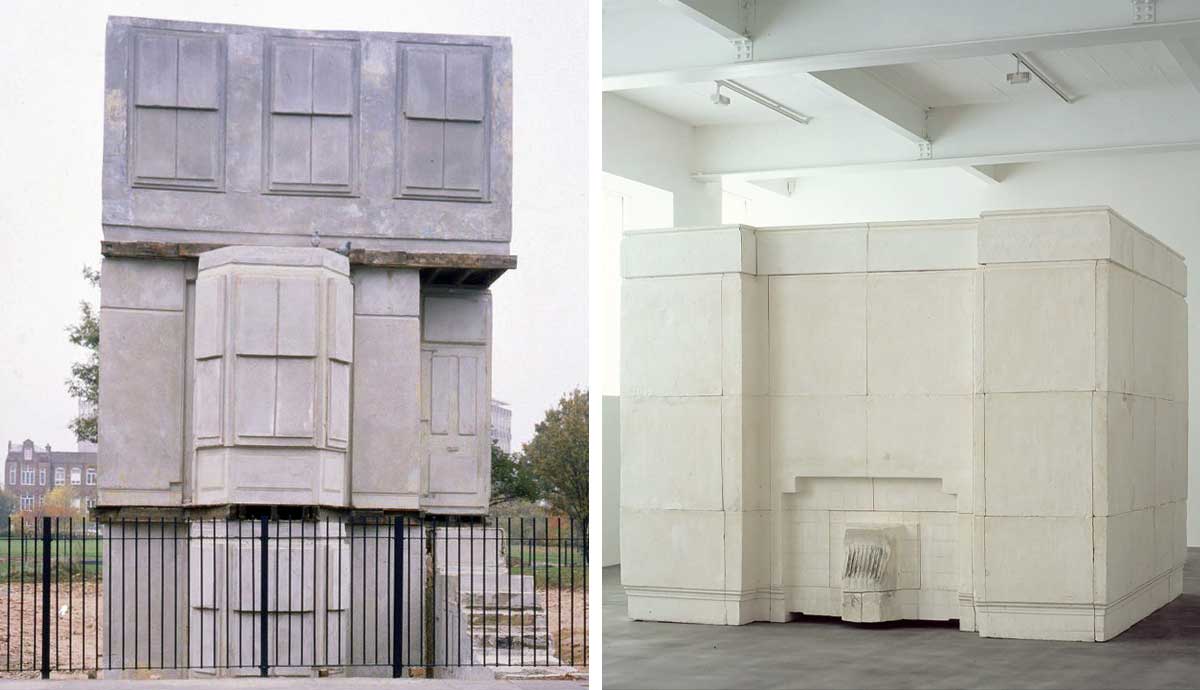
British sculptor Rachel Whiteread made her name in the 1990s as a leading member of the Young British Artists (YBAs) group. Since then, she has been making her strangely hypnotic cast sculptures of empty spaces out of a whole range of materials including plaster, metal, concrete, resin, and rubber. From bathtubs and hot water bottles to entire buildings, her casts have taken a whole range of guises, and they invite us to look at the concept of space and memory in a new way, by turning our understanding of the world completely inside out. We look through some of Whiteread’s most famous sculptures in more detail to understand the ideas behind her practice.
Ghost, 1990

This large scale, ghostly sculpture was a breakthrough artwork for Rachel Whiteread, securing her reputation as a leading British artist. By now Whiteread has been making plaster casts of domestic objects imbued with bodily connotations, such as hot water bottles, bath tubs and sinks. In this much larger work of art she has cast the entire room of a Victorian parlor in plaster. She began by dividing the room into a gridded, minimalist system, and carefully cast each area in a square shape on a steel frame. Once she had cast every section of the room, she arranged the plaster blocks together to create an inside-out version of the space. Rachel Whiteread first unveiled this artwork at London’s Chisenhale Gallery, to great critical acclaim.
Untitled (House), 1993

In Untitled (House), Rachel Whiteread made a concrete cast of the entire interior space of a three-storey building in London’s East End which was already earmarked for demolition. Of all the artworks in her career to date, this one has been the most controversial, attracting equal amounts of criticism and praise, and ultimately leading her to win the Turner Prize in 1993. Along with a team of assistants, Rachel Whiteread filled in the empty space of the building with concrete, pouring it over a metal armature to ensure her final sculpture didn’t collapse.

Once the house was filled in, she set about removing the exterior “brick by brick,”, in order to remove every last trace of its former identity. The result was a whopping great mass of concrete resembling the cold aesthetics of Brutalist architecture, yet it also had a strange intimacy, revealing rarely seen private spaces to the wider public. Eventually Whiteread’s sculpture was demolished in order to make way for planned redevelopments of the area, but her artwork made a powerful statement about the way urban demolition can so often wipe away memories of the past.
Holocaust Memorial, 1995-2000

Situated in Vienna’s Judenplatz, Whiteread’s eerie Holocaust Memorial is a permanent public art sculpture which she was commissioned to create to commemorate the countless victims of the Holocaust. Also known as the ‘Nameless Library’, the sculpture resembles the inside of a library, containing books turned outwards so we cannot see their spines, and the inside of the entry doors forever closed. The memorial reflects on the countless untold stories that were lost during this mass tragedy, never to be retrieved. While we can imagine this could be the inside of a real library, Rachel Whiteread creates a fictional space here by casting each row of books and the doorway separately in plaster, before assembling the units together into a solid, foreboding concrete mass.
Embankment, 2005

Whiteread’s Embankment was made as a commission for Tate Gallery’s Turbine Hall in London, in 2005. She made the monumental and all-consuming sculpture by making 14,000 casts of the inside of cardboard boxes, using white polythene. Whiteread then stacked the boxes into a series of columns and towers throughout the Turbine Hall for viewers to walk through. Whiteread made the sculpture following the death of her mother, and the subsequent process of storing and packing that ensued. She argued the humble cardboard box is present during so many aspects of our lives as we move from one state to another, and they often contain emblems and objects loaded with unspoken, intimate memories.










